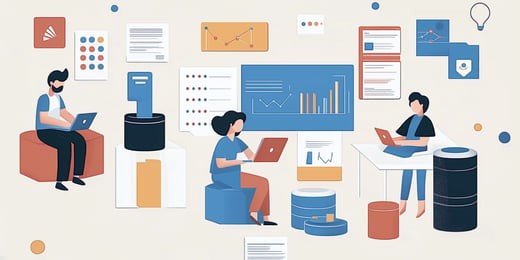As AI rapidly transforms the workplace, a concerning trend has recently caught attention: a significant generational divide in AI adoption. As recently discussed on the Sidecar Sync podcast, this gap poses a critical challenge for associations looking to stay competitive and innovative. Let's explore this divide and discuss strategies to bridge it within your organization.
Understanding the AI Generation Gap
A recent DICE survey of U.S. technology professionals revealed stark differences in AI usage across age groups. While 40% of tech workers aged 18-24 use AI at least weekly on the job, nearly half of professionals 55 or older don't use AI technology at all. This disparity could significantly disrupt enterprise plans for AI adoption, including those of associations.
Current State of AI Impact in the Workplace
Despite the hype surrounding AI, survey says its impact on work has been limited so far. Over half of the survey respondents reported that AI has only slightly impacted their work. However, there's a notable generational split in concerns about AI's career impact. Younger professionals (34 and under) are more worried about AI affecting their careers compared to older workers (45 and above).
The Urgency of AI Adoption
The pace of AI advancement is unprecedented, outstripping previous technological revolutions like the internet or mobile technology. What sets AI apart is its deeply personal nature - it's not just a new tool, but a technology that many fear could fundamentally change our way of life or even replace human workers.
However, as industry leaders commonly put it, "It is unlikely you by yourself will be displaced by AI, but it is extremely likely that you will be replaced by someone who's very good at AI if you're not." This underscores the urgency for all employees, regardless of age, to embrace AI skills.
Challenges in AI Adoption
Several obstacles hinder widespread AI adoption:
- Lack of clarity on staff's existing AI proficiency
- Difficulty in developing effective upskilling strategies
- Emotional reactions and resistance to AI, particularly among older workers
Strategies for Bridging the AI Generation Gap
- Leadership's Role: Association leaders must champion AI adoption, emphasizing its importance as a fundamental skill akin to using a computer or smartphone.
- Focus on Capabilities, Not Technicalities: For many staff members, especially senior leadership, understanding AI's capabilities is more crucial than mastering its technical details.
- Tiered Training Approaches: Develop training programs that cater to different proficiency levels and job roles.
- Address Emotional Resistance: Acknowledge and address fears about AI, focusing on how it can enhance rather than replace human work.
The Changing Nature of AI Proficiency
Interestingly, as AI systems become more sophisticated, they're also becoming easier to use. While current AI skills like prompt engineering are valuable, future AI interactions may be as simple as having a conversation. This evolution means that even those who are hesitant now may find AI more accessible in the near future.
Implications for Association Leadership
For association executives, personal AI literacy is no longer optional. AI isn't just a technology issue; it's a strategic business tool. Leaders who understand AI's capabilities can envision innovative ways to leverage their association's unique data and content, creating new value for members.
As many experts have noted, "If you don't know that power tools exist, you have a legion of carpenters who use hand tools to do your work." In the same way, associations that don't embrace AI risk falling behind more innovative competitors.
Conclusion
The AI generation gap is a critical challenge, but it's also an opportunity. Associations that successfully bridge this divide can create a more adaptable, innovative workforce capable of leveraging AI to better serve members and advance their mission.
AI is rapidly becoming integrated into all aspects of work, and soon, it may be as ubiquitous and unremarkable as email. By proactively addressing the AI generation gap, you can ensure your association remains relevant, competitive, and ready to seize the opportunities of the AI-driven future. It is not essential to attain AI expertise overnight, but more important to foster a culture of continuous learning and adaptation.
Start the conversation about AI in your association today! Check out Sidecar’s FREE monthly Intro to AI Webinar for Associations and Nonprofits to introduce yourself and your team to AI strategies sooner rather than later.
September 12, 2024

